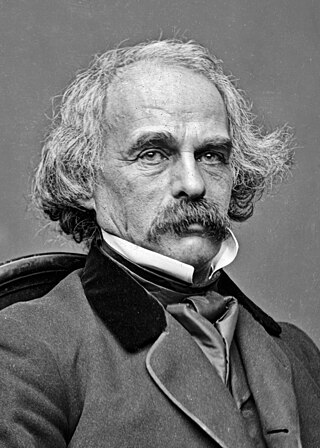
Nathaniel Hawthorne was an American novelist and short story writer. His works often focus on history, morality, and religion.

Delia Salter Bacon was an American writer of plays and short stories and Shakespeare scholar. She is best known for her work on the authorship of Shakespeare's plays, which she attributed to social reformers including Francis Bacon, Sir Walter Raleigh and others.
This article contains information about the literary events and publications of 1845.

The Scarlet Letter: A Romance is a work of historical fiction by American author Nathaniel Hawthorne, published in 1850. Set in the Puritan Massachusetts Bay Colony during the years 1642 to 1649, the novel tells the story of Hester Prynne, who conceives a daughter with a man to whom she is not married and then struggles to create a new life of repentance and dignity. As punishment, she must wear a scarlet letter 'A'. Containing a number of religious and historic allusions, the book explores themes of legalism, sin and guilt.

James Thomas Fields was an American publisher, editor, and poet. His business, Ticknor and Fields, was a notable publishing house in 19th century Boston.
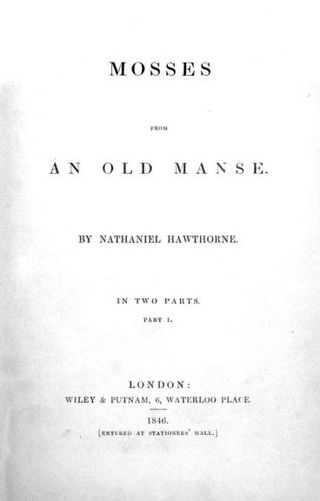
Mosses from an Old Manse is a short story collection by Nathaniel Hawthorne, first published in 1846.

The Old Manse is a historic manse in Concord, Massachusetts, United States, notable for its literary associations. It is open to the public as a nonprofit museum owned and operated by the Trustees of Reservations. The house is located on Monument Street, with the Concord River just behind it. The property neighbors the North Bridge, a part of Minute Man National Historical Park.

Septimus Winner was an American songwriter of the 19th century. He used his own name, and also the pseudonyms Alice Hawthorne, Percy Guyer, Mark Mason, Apsley Street, and Paul Stenton. He was also a teacher, performer, and music publisher.
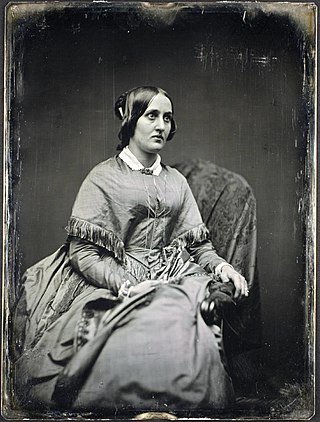
Sara Jane Lippincott was an American writer, poet, correspondent, lecturer, and newspaper founder. One of the first women to gain access into the Congressional press galleries, she used her questions to advocate for social reform and women's rights.
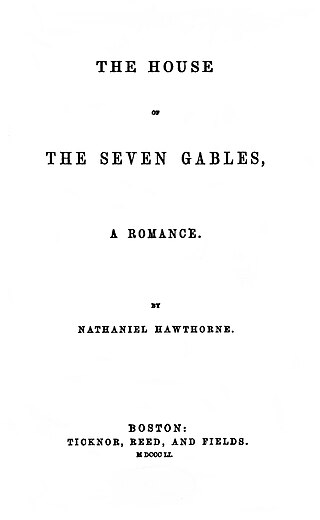
The House of the Seven Gables: A Romance is a Gothic novel written beginning in mid-1850 by American author Nathaniel Hawthorne and published in April 1851 by Ticknor and Fields of Boston. The novel follows a New England family and their ancestral home. In the book, Hawthorne explores themes of guilt, retribution, and atonement, and colors the tale with suggestions of the supernatural and witchcraft. The setting for the book was inspired by the Turner-Ingersoll Mansion, a gabled house in Salem, Massachusetts, belonging to Hawthorne's cousin Susanna Ingersoll, as well as ancestors of Hawthorne who had played a part in the Salem Witch Trials of 1692. The book was well received upon publication and has been adapted several times to film and television.

"Feathertop" is a short story by Nathaniel Hawthorne, first published in 1852. The moral tale uses a metaphoric scarecrow named Feathertop and its adventure to offer the reader a conclusive lesson about human character. It has since been used and adapted in several other media forms, such as opera and theatre.
Nationality words link to articles with information on the nation's poetry or literature.
Eliza (Buckminster) Lee (1792–1864) was an American author. She wrote a number of prose works in various genres, including biography, memoir, and fiction, and she translated from German.

"Egotism; or, The Bosom-Serpent" is a short story by Nathaniel Hawthorne published in 1843 in The United States Magazine and Democratic Review in New York.

Frank Preston Stearns (1846–1917), the son of abolitionist George Luther Stearns, was a writer and abolitionist from Massachusetts during the 19th century. In addition to collaborating with Elizur Wright in ambitious abolitionist projects, such as the American Anti-Slavery Society, he is credited with several seminal works exploring the lives and careers of important American public figures and authors of note, including The Life and Genius of Nathaniel Hawthorne, The Life of Prince Otto von Bismarck, and The Life and Public Services of George Luther Stearns.

Ticknor and Fields was an American publishing company based in Boston, Massachusetts. Founded as a bookstore in 1832, the business published many 19th-century American authors, including Ralph Waldo Emerson, Nathaniel Hawthorne, Henry James, Henry Wadsworth Longfellow, Harriet Beecher Stowe, Henry David Thoreau, and Mark Twain. It also became an early publisher of The Atlantic Monthly and North American Review.
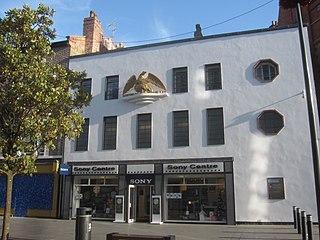
The United States Consulate in Liverpool, England, was established in 1790, and was the first overseas consulate founded by the then fledgling United States of America. Liverpool was at the time an important center for transatlantic commerce and a vital trading partner for the former Thirteen Colonies. Among those who served the United States as consul in Liverpool were the writer Nathaniel Hawthorne, the spy Thomas Haines Dudley, and John S. Service, who was driven out of the United States Foreign Service by McCarthyite persecution. After World War II, as Liverpool declined in importance as an international port, the consulate was eventually closed down. The American Consulate in Liverpool was situated on the third floor of the Cunard building on the Pierhead and permanently closed in 1975.
American gothic fiction is a subgenre of gothic fiction. Elements specific to American Gothic include: rationality versus the irrational, puritanism, guilt, the uncanny, ab-humans, ghosts, and monsters.

The Token (1829–1842) was an American annual, illustrated gift book, containing stories, poems and other light and entertaining reading. In 1833, it became The Token and Atlantic Souvenir.
Henry Arlin Turner was an American biographer and professor of English, specializing in American literature of the 19th century.














